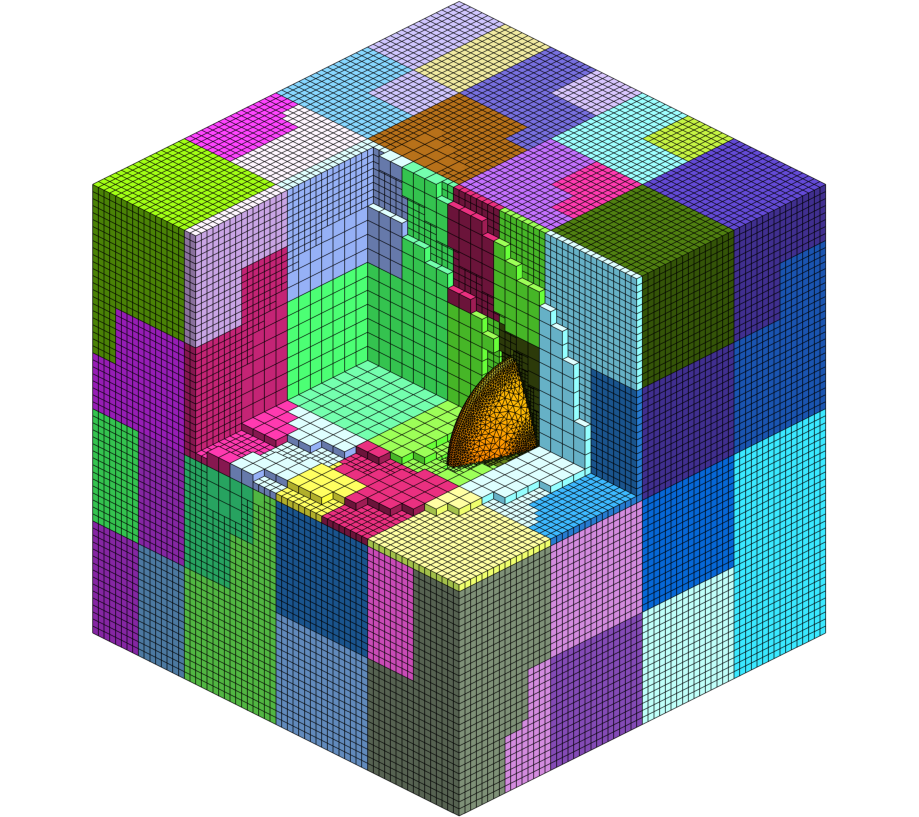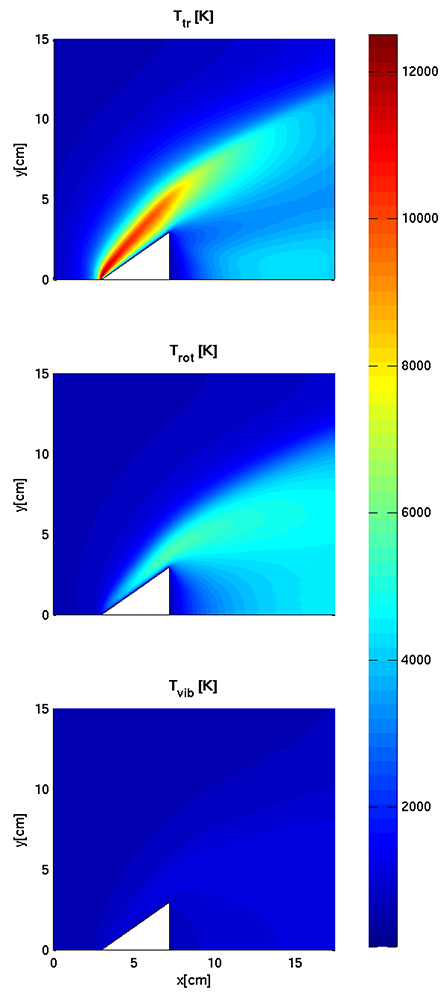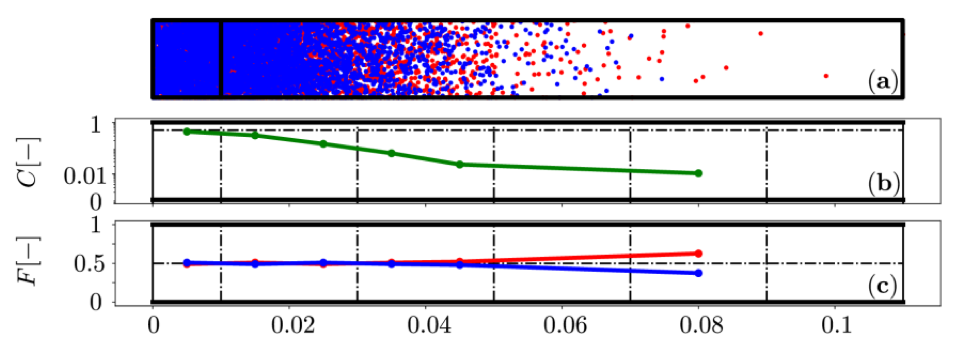Rarefied Gas Kinetics & Aerodynamics
The physics of gas flows in rarefied regimes can significantly deviate from the conventional Navier-Stokes-Fourier description. The Boltzmann equation and in particular direct simulation Monte Carlo (DSMC) offer invaluable tools for simulations of these non-equilibrium scenarios. However, the computational efficiency of DSMC decays sharply as soon as the Knudsen number becomes small. In order to cope with this severe deficiency, a Fokker-Planck (FP) approximation of the Boltzmann equation is considered in this research effort. The model replaces the effect of molecular collisions with a set of continuous stochastic differential equations, which leads to favorable computational properties, since here the computational particles do not collide with each other, but follow independent stochastic paths. The FP model with a linear drift term was originally proposed by Jenny et al. [external page 2010] for simulations of rarefied gas flows. Later, the model was generalized by Gorji et al. [external page 2011] in order to achieve the correct Prandtl number of 2/3 for monatomic gas.
Fokker-Planck-DSMC Solution Algorithm

Fluid-flows covering a wide range of Knudsen numbers (Kn) arise for example in space vehicle thrusters or at vehicle reentry (Kn is defined as the ratio of molecular mean-free path to a relevant flow length scale). For the computationally efficient simulation of such flows, we present a combined FP-DSMC method [external page Gorji and Jenny 2015]. Here, the FP collision kernel is applied in flow regions with low to moderate Kn [external page Gorji and Jenny 2014], while DSMC is deployed in regions where Kn is large. This ensures that both methods are used where they are accurate and computationally efficient. Our implementation applies space-filling-curve domain decomposition and adaptive mesh refinement (see figure) to allow for fast parallel computations, as outlined by Küchlin and Jenny [external page 2017 and external page 2018]. Read more
Complex Gas Glows

The FP kinetic model has been generalized for diatomic and mixture flows by Gorji and Jenny [external page 2012, external page 2013, and external page 2014]. Here vibrational and rotational modes are treated individually using continuous stochastic processes for each degree of freedom. The stochastic models to evolve the internal degrees of freedom are constructed such that the equipartition theorem is fulfilled in equilibrium and the Landau-Teller relaxation for internal energy distributions is recovered.
Gas Separation Mechanisms
Gas flows in micro-nano systems offer new opportunities for designing mechanical systems. A novel demixing device concept is investigated, which is based on micro-nano gas flows [external page Gorji and Jenny 2013]. The gas mixture under consideration is stimulated by laser light finely tuned for vibrational/rotational excitation of the target gas species. Due to the partial conversion of the stored internal energy into translational energy upon successive collisions of the stimulated molecules with the device walls, excited molecules attain higher velocities and consequently larger diffusion with respect to unstimulated molecules [external page Andric, Gorji, and Jenny 2016]. The importance of this technique lies in the fact that it operates even if target and inert species have similar mass and similar sizes, since the excitation is based on the vibrational/rotational frequencies of the target molecules.

To gain a better understanding of the intra-molecular energy redistribution during wall collisions, detail molecular dynamics simulations of nitrogen molecules colliding with a graphite surface were conducted and limitations of parametric gas-surface interaction kernels were identified [external page Andric and Jenny 2018]. In a follow-up study, an alternative more accurate scattering kernel was developed by combining the MD data with a non-parametric density estimator that allows for conditional resampling of energy states for scattered molecules [external page Andric, Meyer, and Jenny 2019]. Andric and Jenny [external page 2020] combined the previously developed scattering kernel with a DSMC method to simulate the envisioned separation device. They find that selective rotational excitation of a certain nitrogen isotope indeed leads after wall collisions and for Kn > 10 to a clearly noticeable separation of the excited isotope (see figure).
Schemes for Reducing Bias and Statistical Errors in Monte-Carlo Simulations
Gorji, Andric, and Jenny [external page 2015] tackle the issue of statistical errors, which is common in Monte-Carlo techniques, with a suitable variance reduction method. It is shown that introducing auxiliary stochastic processes with known solutions can substantially reduce the noise of the FP-based particle simulations. The method employs an equilibrium stochastic process, which evolves parallel to the main Langevin process. The correlation between the two processes allows to reduce the statistical error. Note that the proposed scheme is consistent, i.e. no new model assumptions are introduced. Further, in contrast to the deviational schemes for FP equations, such as the two-weight method, the proposed low variance method is free from instabilities. This is a crucial feature, since otherwise the method is not suitable for simulations of low Mach flows.
Gorji, Küchlin, and Jenny [external page 2019a] address the equilibration of statistical errors in simulation domains by preserving a uniform spatial distribution of particles having variable weights. To this end, an adaptive kernel-density-estimation (KDE) technique is devised and combined with a new particle-resampling scheme that applies stratified sampling. The KDE/resampling scheme becomes active in grid cells where particle counts deviate from the target density. An exemplary high-Mach number flow is simulated using DSMC in combination with the new scheme demonstrating the validity of the approach.
In the context of the FP method for rarefied gas dynamics, Jenny, Küchlin, and Gorji [external page 2019b] performed a bias error analysis of the molecular stresses. They identify statistical errors in the estimation of the mean velocity as a bias-error driver and propose an exponential time-averaging scheme for their reduction in time-independent cases. The scheme is successfully applied in different reference tests.
Morphing Wing Aerodynamics
The technology of morphing wings is of interest, since more degrees of freedom can be employed to adapt and control a wing for various purposes in different environments. This project was a collaboration with Profs. Paolo Ermanni, Eduardo Mazza and Manfred Morari (ETH Zürich). Our role was to build predictive virtual models, which allow to design the required structure and control algorithms.
Dmitriev, Molinari, Jenny, and coworkers [external page 2011 and external page 2013] demonstrated that it is possible to extract energy from shear flows, but unfortunately the amount was found to be relatively small in realistic turbulent atmospheres. Subsequently, the aerodynamics of oscillating ring wings have been investigated by Dmitriev and Jenny [external page 2012].